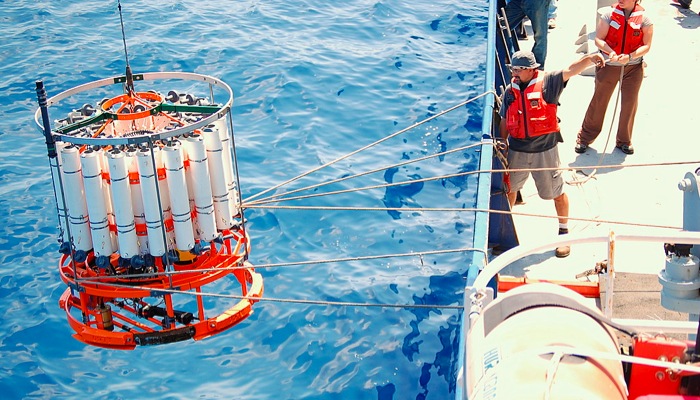
CTD: Complete and Total Disaster
Hi everybody.
So, I got some questions regarding the rosette that I was describing last time, and I thought I'd describe it in a bit more detail for everybody. The blog posting "T-minus 12 days" shows a picture of a CTD. Let me explain something about this first, though. Onboard, we usually refer to the entire thing, frame and all, as the "CTD." However, the actual CTD is only one of the many things mounted on the frame. In that picture, you can see several dark grey PVC bottles. These are important, too, but I'll get to those in a minute. The CTD is actually in the center of the frame, and you can see part of the CTD with a sticker that says "SBE" in that picture. What the CTD does is measure the Conductivity, Temperature, and Depth of the water. From the conductivity, we can determine the salinity, and the depth is actually determined by measuring the pressure.
On our CTD, there is also an altimeter to measure the distance of the CTD from the ocean floor, something to measure optics, an instrument to measurefluorescence, and then all of those bottles. We have 36 in total. The bottles are about 3.5 ft long, and about 8-10 inches in diameter. We have electronics cable that runs from the ship to the CTD, and from this, we can monitor everything from our console inside the ship. We let the CTD sink all the way to about 20 meters off the ocean floor, then send a signal to the CTD to tell it to close one of the bottles. The bottle then is filled with water from that depth. We continue this for up to 36 different depths, from the bottom to the surface. Once we fire off the last bottle, we raise it back onto the ship deck. I assist in this too. Then, all of the chemistry people (and us in charge of the CTD, who it seems have about 15 different responsibilities) basically just pour water into little flasks and bottles using different methods to test for all sorts of parameters in the ocean. I think our list of things we're sampling includes Freon, Oxygen, Dissolved Inorganic Carbon, Alkalinity, pH, Dissolved Organic Carbon, Carbon 14, Colored Dissolved Organic Matter, Tritium, Nutrients, Salts, Silicon Isotopes, and Black Carbon. Most of these are being sampled onboard, but many are being preserved for other people to sample once we return to shore.
The whole CTD itself, frame and all, is probably a little over 6ft tall, and really heavy. I think they said when it is completely full of water, it weighs about 6,000 lbs. Our console is pretty cool, too. We have 12 LCD monitors lined up in a grid of 4 across X 3 down, which shows us the bottom topography by two different echo sounding devices, a live camera feed of the deck where the CTD is launched, the streaming data of Temperature, Conductivity, Oxygen with depth from the actual CTD, information on the amount of wire we're letting out and the CTD depth and distance from the bottom, some sonar stuff, and some other stuff. Its really a pretty cool operation here at sea. I am taking plenty of pictures, and I'll probably be creating a Flickr account when I get back so that you can see them all. That's enough science for now. Cheers!
Austin
Saturday, February 9, 2008